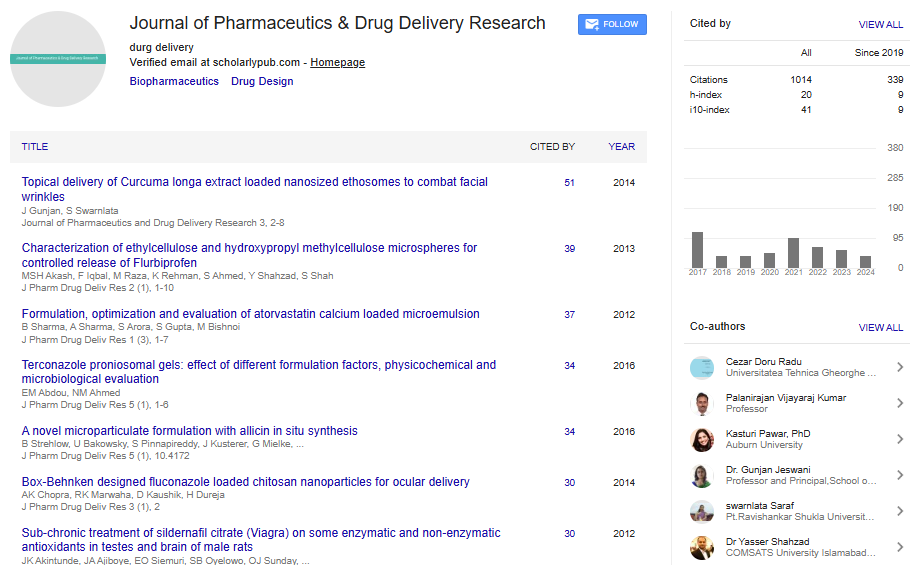Perspective, J Pharm Drug Deliv Res Vol: 10 Issue: 6
Drug Discovery and Improvement in the Development of New Therapeutic Drug Substance
Ross Geller*
Department of Pharmaceutics, University of Florida, Gainesville, United States
*Corresponding author: Ross Geller, Department of Pharmaceutics, University of Florida, Gainesville, United States, Tel: +123589647226; E-mail: rossgeller@gmail.com
Received date: 01 June, 2021; Accepted date: 16 June, 2021; Published date: 25 June, 2021
Keywords: Therapeutic Drug Substance
Editorial Note
Drug studies are a selected manner towards the development of latest therapeutic sellers in this era to satisfy the cutting edge scientific needs. Drug discovery and improvement are the two foremost degrees in the development of new therapeutic drug substance. Drug discovery includes identification and characterization of new goals (enzymes or receptors), synthesis of new lead molecules, screening of latest lead molecules for its in vitro and in vivo biological sports, and physicochemical characterization of leads. The drug discovery and development system calls for near interplay a few of the exceptional clinical area individuals for as many as 10-12 years. Its miles anticipated that only 1 out of 5000 screened compounds is authorized as a new drug. On an average, each new drug molecule calls for 12 ± 15 years to reach the affected person and prices an astounding amount folks 400 ± 650 million energetic pharmaceutical component (API): Any substance or aggregate of substances intended for use in the manufacture of a pharmaceutical dosage form and that, whilst used so, becomes an lively factor of that pharmaceutical dosage shape. Human body is composed of a sequence of membrane boundaries divided via aqueous-stuffed booths. These membrane obstacles are mainly composed of the phospholipid bilayers as a consequence of the orientation of the lipids (phospholipids, glycolipids, and cholesterol) inside the aqueous medium, which surround the cells and also shape intracellular obstacles around the organelles found in cells mitochondria, nucleus, and so on. The phospholipids are amphipathic in nature and feature aligned polar head businesses and lipid “tails,” so the polar head organizations of phospholipid orientate in the direction of the aqueous phases and the lipid tails shape an exceedingly hydrophobic internal middle. As a result, the drug substance releases its hydration detail and will become hydrophobic. The drug disposition across the membrane depends on its lipophilicity and partition coefficient. Here, the protein binding performs an important function. The polar molecules can be dissociated in an aqueous environment; thereby, the hydrophobicity arises and vice versa within the case of nonpolar molecules in a lipophilic environment. Each aspect of an organic compound has a described lipophilicity. Absorption and bile elimination price are molecular weight dependent. Decrease molecular-weight compounds have higher absorption and less bile excretion when in comparison to the better-molecular-weight compounds. Pills with higher lipophilicity can be better absorbed from the intestine. Bio pharmaceutics is a chief branch in pharmaceutical sciences which relates between the physicochemical properties of a drug in dosage shape and the pharmacology, toxicology, or clinical reaction found after its management. Drug efficacy and protection are dependent on the dosing routine. The foremost dosage and dosing intervals can be quite one of a kind for one of a kind pills. Moreover, for a single drug, the premiere dosage may be exceptional widely among sufferers. It isn't sufficient to recognize what the drug does to the body; it is also essential to know what the body does to the drug. The knowledge of the pharmacodynamics and pharmacokinetic residences of the drug and its metabolites in humans and animals is critical to apprehend its exclusive consequences among species and for adjusting drug dosing. The plasma awareness of the drug is the primary idea of pharmacokinetics. based totally on protein binding of the drug, the attention of loose drug available in the stream affects substantially the dose calculations. The concentration of drug inside the plasma is in equilibrium with a few tissues inside the frame. Blood is the transporter of many essential substances and nutrients for the whole body and therefore contains many endogenous and exogenous compounds in special concentrations. Organic samples (tissue extracts, plasma, serum, or urine) are extraordinarily complicated matrices made out of many additives that can intervene in estimation/quantification; therefore, biological samples cannot generally be injected without delay into the studying machine for the dedication of lively principle. Pattern pretreatment is required for accomplishing sufficient sensitivity and selectivity to determine the lively precept. Chemical assays of excessive pleasant which consist of ok sensitivity, selectivity and reproducibility are critical for acquiring treasured facts. Bio analysis is a sub discipline of analytical chemistry protecting the quantitative size pills and their metabolites in biological systems. Bio analysis approach can provide a quantitative measure of the energetic drug and its metabolites for the cause of pharmacokinetics. Various analytical tool techniques inclusive of Excessive-Performance Liquid Chromatography (HPLC) or Gas Chromatography (GC) or Ultra-Performance Liquid Chromatography (UPLC) with variety of detectors including UV, fluorescent, diode array, flame ionization, electron capture and mass spectrometry, and capillary electrophoresis–mass spectrometry can be used. For macromolecule, ELISA or RIA technique can be used for quantification
 Spanish
Spanish  Chinese
Chinese  Russian
Russian  German
German  French
French  Japanese
Japanese  Portuguese
Portuguese  Hindi
Hindi 
